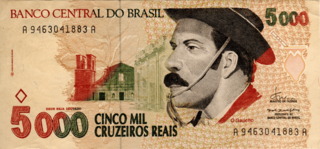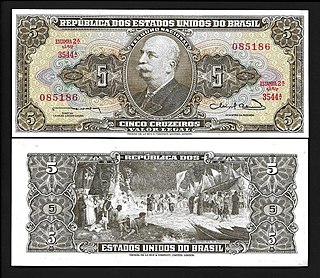
The Brazilian currency has been renamed and redefined several times through its history. [1] [2] [3] [4] [5] Since 1994, the official one is the Brazilian real (plural reais, with symbol R$ and ISO code BRL.

The Brazilian currency has been renamed and redefined several times through its history. [1] [2] [3] [4] [5] Since 1994, the official one is the Brazilian real (plural reais, with symbol R$ and ISO code BRL.
| Introduction | Withdrawal | Duration | Name | Symbol | ISO | Conversion |
|---|---|---|---|---|---|---|
| — | — | — | Portuguese Real | Rs [lower-alpha 1] | N/A | |
| 12 October 1822 [lower-alpha 2] | [7] | 120y 20d | Real (old, pl. réis) | Rs [lower-alpha 1] | = 1 Portuguese real | |
| 1 November 1942 [7] | [8] | 24y 3m 12d | Cruzeiro (first) | Cr$ [lower-alpha 3] | = 1,000 réis | |
| 13 February 1967 [8] | 30 June 1972 [10] | 3y 3m 2d | Cruzeiro novo | NCr$ [lower-alpha 3] | = 1,000 cruzeiros | |
| 15 May 1970 [10] | 15y 9m 12d | Cruzeiro (second) | Cr$ [lower-alpha 3] | BRB | = 1 cruzeiro novo | |
| 27 February 1986 | 2y 10m 19d | Cruzado | Cz$ | BRC | = 1,000 cruzeiros | |
| 15 January 1989 | 1y 2m 1d | Cruzado novo | NCz$ | BRN | = 1,000 cruzados | |
| 16 March 1990 | 3y 4m 15d | Cruzeiro (third) | Cr$ [lower-alpha 3] | BRE | = 1 cruzado novo | |
| 1 August 1993 | 11m | Cruzeiro real | CR$ | BRR | = 1,000 cruzeiros | |
| 1 July 1994 | (still in use) | 29y 15d | Real (new, pl. reais) | R$ | BRL | = 2,750 cruzeiros reais |
Note that the dates of various currencies overlap. For example, the cruzeiro novo was still legal tender for 2 years after the second cruzeiro was introduced.
Not considering inflation, one modern Brazilian real is equivalent to 2,750,000,000,000,000,000 times the old real, that is, 2.75×1018 (2.75 quintillion) réis.
Before leaving Brazil in 1821, the Portuguese royal court withdrew all the bullion currency it could from banks in exchange for what would become worthless bond notes; [11] [12]

The following tables indicate what banknotes were present in each of the currencies of Brazil, except for the provisional issues of banknotes to exchange gold in the colonial period:
| Symbol | Meaning |
|---|---|
| Currency had a banknote with this face value | |
| Currency did not have a banknote with this face value | |
| Currency had legal tender with this face value in the form of an overstamped banknote from the previous currency | |
| Currency had a project to launch a banknote, but it never came into circulation |
| Currency\Face value |
|---|
| Real (old) |
| Cruzeiro (1st) |
| Cruzeiro novo |
| Cruzeiro (2nd) |
| Cruzado |
| Cruzado novo |
| Cruzeiro (3rd) |
| Cruzeiro real |
| Real (new) |
| 0.01 | 0.05 | 0.10 | 0.50 | 1 | 2 | 5 | 10 | 20 | 50 | 100 | 200 | 500 | 1,000 | 2,000 | 5,000 | 10,000 | 20,000 | 30,000 | 50,000 | 100,000 | 200,000 | 500,000 | 1,000,000 | 5,000,000 |
|---|---|---|---|---|---|---|---|---|---|---|---|---|---|---|---|---|---|---|---|---|---|---|---|---|
No single face value has been present in all historical Brazilian banknotes. For example, a face value of 100 is missing from the old real (as its lowest denomination of banknote is 500 Rs) and from the provisional cruzeiro novo (as its only banknotes were overstamps of the first cruzeiro, and the highest denomination was NCr$10). It is, however, present in all the other currencies:
The following tables indicate what coins were present in each of the currencies of Brazil, with the exception of réis: [lower-alpha 4]
| Symbol | Meaning |
|---|---|
| Currency had a circulating coin with this face value | |
| Currency did not have any coin with this face value | |
| Currency had legal tender with this face value in the form of a non-circulating commemorative coin | |
| The currency took advantage of coins of the previous standard was issued coins in such values | |
| Currency had a project to launch a coin, but it never came into circulation |
| Currency\Face value |
|---|
| Cruzeiro (1st) |
| Cruzeiro novo |
| Cruzeiro (2nd) |
| Cruzado |
| Cruzado novo |
| Cruzeiro (3rd) |
| Cruzeiro real |
| Real (new) |
| 0.01 | 0.02 | 0.05 | 0.10 | 0.20 | 0.25 | 0.50 | 1 | 2 | 3 | 4 | 5 | 10 | 20 | 50 | 100 | 200 | 300 | 500 | 1,000 | 2,000 | 5,000 |
|---|---|---|---|---|---|---|---|---|---|---|---|---|---|---|---|---|---|---|---|---|---|
No single face value has been present in all historical Brazilian coins. For example, a face value of 1 is missing from the cruzeiro novo (as its highest denomination of coin is NCr$0.50 because it's a transitory monetary standard between the cruzeiro issued between 1942 and 1967 and the cruzeiro issued after 1970) and from the old real and the cruzeiro real (as their lowest denomination of coin is 5 Rs and CR$5, respectively). It is, however, present in all the other currencies:

 ", that is, 1000 réis.
", that is, 1000 réis.

The Portuguese escudo was the currency of Portugal from May 22, 1911, until the introduction of the euro on January 1, 2002. The escudo was subdivided into 100 centavos. The word escudo derives from the scutum shield.

The Macanese pataca or Macau pataca is the currency of the Macau Special Administrative Region of the People's Republic of China. It is subdivided into 100 avos, with 10 avos called ho (毫) in Cantonese.
Brazilian cruzeiro refers to any of four distinct Brazilian currencies:

The cruzado was the currency of Brazil from 1986 to 1989. It replaced the second cruzeiro in 1986, at a rate of 1 cruzado = 1000 cruzeiros (novos) and was replaced in 1989 by the cruzado novo at a rate of 1000 cruzados = 1 cruzado novo.

The cruzeiro real was the short-lived currency of Brazil between August 1, 1993, and June 30, 1994. It was subdivided in 100 centavos; however, this unit was used only for accounting purposes, and the coins and banknotes still valid for cruzeiro between 10 and 500 cruzeiros were used for the purpose of corresponding to the cents of that coin, especially when the redenomination was carried out. The currency had the ISO 4217 code BRR.

The escudo is the currency of the Republic of Cape Verde. One escudo is subdivided into one hundred centavos.

The dollar sign, also known as peso sign, is a symbol consisting of a capital "S" crossed with one or two vertical strokes, used to indicate the unit of various currencies around the world, including most currencies denominated "peso" and "dollar". The explicitly double-barred sign is called cifrão in Portuguese.

The real was the unit of currency of Portugal and the Portuguese Empire from around 1430 until 1911. It replaced the dinheiro at the rate of 1 real = 840 dinheiros and was itself replaced by the escudo at a rate of 1 escudo = 1000 réis. The escudo was further replaced by the euro at a rate of 1 euro = 200.482 escudos in 2002.
The real was the currency of Portuguese Cape Verde until 1914. It was equal to the Portuguese real. Portuguese coins were used but banknotes were issued by the Banco Nacional Ultramarino specifically for Cape Verde starting in 1865. The real was replaced by the Cape Verdean escudo, at a rate of 1000 réis = 1 escudo.

The Azorean real, also known as the Azorean Moeda Insulana was the currency of the Portuguese archipelago of the Azores, used until 1931.

The Cruzado Novo was the short-lived currency of Brazil between 15 January 1989 and 15 March 1990. It replaced the cruzado in the rate of 1000 cruzados = 1 cruzado novo. It had the symbol and the ISO 4217 code BRN. In 1990, the cruzado novo was renamed the (third) cruzeiro. This currency was subdivided in 100 centavos.

The first official currency of Brazil was the real, with the symbol Rs$. As the currency of the Portuguese empire, it was in use in Brazil from the earliest days of the colonial period, and remained in use until 1942, when it was replaced by the cruzeiro.

The Brazilian real is the official currency of Brazil. It is subdivided into 100 centavos. The Central Bank of Brazil is the central bank and the issuing authority. The real replaced the cruzeiro real in 1994.

In 1986 because of inflation banknotes of the cruzado were issued by Central Bank of Brazil in denominations of 10, 50, 100, 500, 1000, 5000 and 10 000 cruzados. This bank had the sole authority to issue cruzado notes and Casa da Moeda do Brasil was the sole printer of these banknotes. Cruzado notes on the front/obverse featured prominent people while on the back/reverse depicted buildings and/or activities of those people mentioned before. Between 1989 and 1990 cruzado currency had also been replaced, this time by cruzado novo at a rate of 1 cruzado to 1000 cruzados novos.

The (first) cruzeiro (Cr$) was the official currency of Brazil from 1942 to 1967. It replaced the old real, which had been in use since colonial times, at the rate of Rs 1$000 = Cr$1, It was in turn replaced by the cruzeiro novo, at the rate of Cr$1,000 = NCr$1.

The cruzeiro was the currency of Brazil between 1990 and 1993. It was the third iteration of a Brazilian currency named "cruzeiro", and replaced the cruzado novo at par. It was used until 1993, when it was replaced by the cruzeiro real at a rate of 1 cruzeiro real = 1000 cruzeiros.

The cruzeiro, initially denominated cruzeiro novo, was the currency of Brazil between 1967 and 1986. It is the second of the 3 historical Brazilian currencies called "cruzeiro".

The Cruzeiro sign (₢) is a typographical abbreviation or ligature consisting of a capital Latin letter "C" with a nested lower-case letter "r", connected in a single glyph.